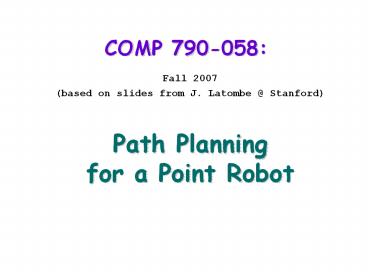COMP 790-058: - PowerPoint PPT Presentation
1 / 45
Title:
COMP 790-058:
Description:
Visibility graph, Voronoi diagram, exact cell decomposition, navigation function ... visibility graph, Voronoi diagram - Identify start/goal cell - Search graph ... – PowerPoint PPT presentation
Number of Views:19
Avg rating:3.0/5.0
Title: COMP 790-058:
1
COMP 790-058
- Fall 2007
- (based on slides from J. Latombe _at_ Stanford)
- Path Planning for a Point Robot
2
Main Concepts
- Reduction to point robot
- Search problem
- Graph search
- Configuration spaces
3
Configuration SpaceTool to Map a Robot to a
Point
4
Problem
free space
free path
g
5
Problem
semi-free path
6
Types of Path Constraints
- Local constraints lie in free space
- Differential constraints have bounded
curvature - Global constraints have minimal length
7
Homotopy of Free Paths
8
Motion-Planning Framework
Continuous representation
Discretization
Graph searching (blind, best-first, A)
9
Path-Planning Approaches
- RoadmapRepresent the connectivity of the free
space by a network of 1-D curves - Cell decompositionDecompose the free space into
simple cells and represent the connectivity of
the free space by the adjacency graph of these
cells - Potential fieldDefine a function over the free
space that has a global minimum at the goal
configuration and follow its steepest descent
10
Roadmap Methods
- Visibility graphIntroduced in the Shakey project
at SRI in the late 60s. Can produce shortest
paths in 2-D configuration spaces
11
Simple Algorithm
- Install all obstacles vertices in VG, plus the
start and goal positions - For every pair of nodes u, v in VG
- If segment(u,v) is an obstacle edge then
- insert (u,v) into VG
- else
- for every obstacle edge e
- if segment(u,v) intersects e
- then goto 2
- insert (u,v) into VG
- Search VG using A
12
Complexity
- Simple algorithm O(n3) time
- Rotational sweep O(n2 log n)
- Optimal algorithm O(n2)
- Space O(n2)
13
Rotational Sweep
14
Rotational Sweep
15
Rotational Sweep
16
Rotational Sweep
17
Rotational Sweep
18
Reduced Visibility Graph
tangent segments
? Eliminate concave obstacle vertices
19
Generalized (Reduced) Visibility Graph
tangency point
20
Three-Dimensional Space
Computing the shortest collision-free path in a
polyhedral space is NP-hard
21
Roadmap Methods
- Voronoi diagram Introduced by Computational
Geometry researchers. Generate paths that
maximizes clearance. O(n log n) timeO(n) space
22
Roadmap Methods
- Visibility graph
- Voronoi diagram
- SilhouetteFirst complete general method that
applies to spaces of any dimension and is singly
exponential in of dimensions Canny, 87 - Probabilistic roadmaps
23
Path-Planning Approaches
- RoadmapRepresent the connectivity of the free
space by a network of 1-D curves - Cell decompositionDecompose the free space into
simple cells and represent the connectivity of
the free space by the adjacency graph of these
cells - Potential fieldDefine a function over the free
space that has a global minimum at the goal
configuration and follow its steepest descent
24
Cell-Decomposition Methods
- Two classes of methods
- Exact cell decompositionThe free space F is
represented by a collection of non-overlapping
cells whose union is exactly FExample
trapezoidal decomposition
25
(No Transcript)
26
Trapezoidal decomposition
27
Trapezoidal decomposition
28
Trapezoidal decomposition
29
Trapezoidal decomposition
30
Planar sweep ? O(n log n) time, O(n) space
31
Cell-Decomposition Methods
- Two classes of methods
- Exact cell decomposition
- Approximate cell decompositionF is represented
by a collection of non-overlapping cells whose
union is contained in FExamples quadtree,
octree, 2n-tree
32
Octree Decomposition
33
Sketch of Algorithm
- Compute cell decomposition down to some
resolution - Identify start and goal cells
- Search for sequence of empty/mixed cells between
start and goal cells - If no sequence, then exit with no path
- If sequence of empty cells, then exit with
solution - If resolution threshold achieved, then exit with
failure - Decompose further the mixed cells
- Return to 2
34
Path-Planning Approaches
- RoadmapRepresent the connectivity of the free
space by a network of 1-D curves - Cell decompositionDecompose the free space into
simple cells and represent the connectivity of
the free space by the adjacency graph of these
cells - Potential fieldDefine a function over the free
space that has a global minimum at the goal
configuration and follow its steepest descent
35
Potential Field Methods
- Approach initially proposed for real-time
collision avoidance Khatib, 86. Hundreds of
papers published on it.
Goal
Robot
36
Attractive and Repulsive fields
37
Local-Minimum Issue
- Perform best-first search (possibility of
combining with approximate cell decomposition) - Alternate descents and random walks
- Use local-minimum-free potential (navigation
function)
38
Sketch of Algorithm (with best-first search)
- Place regular grid G over space
- Search G using best-first search algorithm with
potential as heuristic function
39
Simple Navigation Function
0
5
40
Simple Navigation Function
1
2
2
3
1
2
1
0
2
3
3
4
5
4
41
Simple Navigation Function
1
2
2
3
1
2
1
0
2
3
3
4
5
4
42
Completeness of Planner
- A motion planner is complete if it finds a
collision-free path whenever one exists and
return failure otherwise. - Visibility graph, Voronoi diagram, exact cell
decomposition, navigation function provide
complete planners - Weaker notions of completeness, e.g.-
resolution completeness (PF with best-first
search)- probabilistic completeness (PF with
random walks)
43
- A probabilistically complete planner returns a
path with high probability if a path exists. It
may not terminate if no path exists. - A resolution complete planner discretizes the
space and returns a path whenever one exists in
this representation.
44
Preprocessing / Query Processing
- Preprocessing Compute visibility graph, Voronoi
diagram, cell decomposition, navigation function - Query processing- Connect start/goal
configurations to visibility graph, Voronoi
diagram- Identify start/goal cell- Search graph
45
Issues for Future Classes
- Space dimensionality
- Geometric complexity of the free space
- Constraints other than avoiding collision
- The goal is not just a position to reach
- Etc































